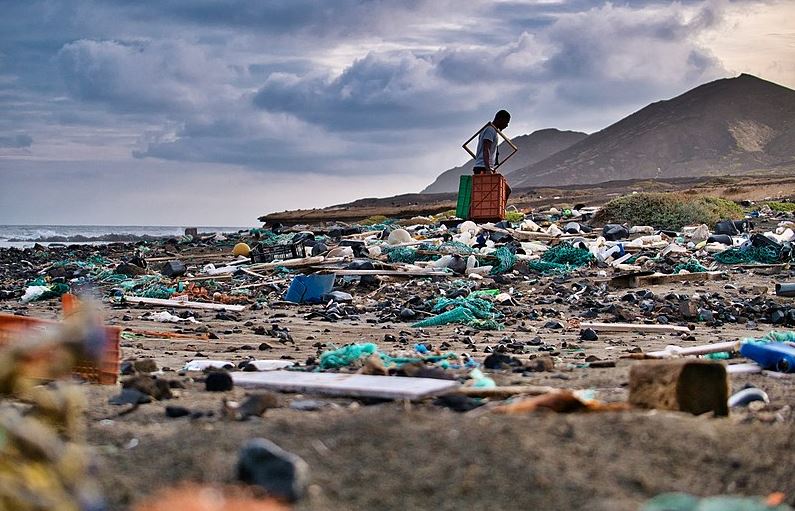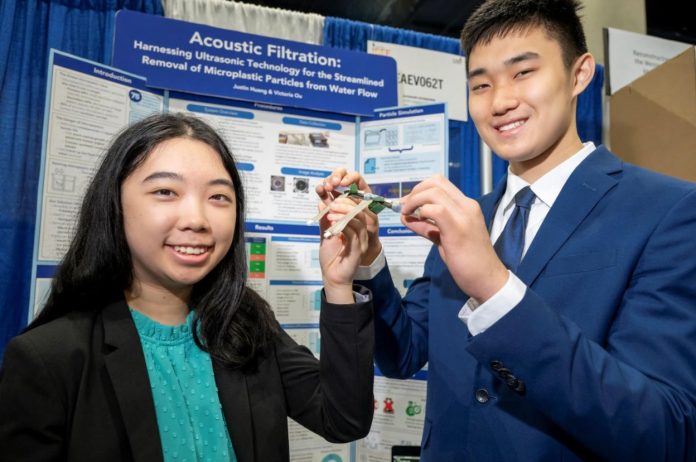By Micah Yip
High school students Victoria Ou and Justin Huang have known each other since late
elementary school, around the same time Ou discovered the growing environmental issue of
microplastics.
“In fifth grade, I had to do a science project on a world issue and I chose plastic pollution,” Ou said. “I discovered…microplastics were getting into our food and our water. When I told Justin about this later, both of us decided that we needed to do something, because it was a serious issue that affected everyone, including ourselves.”
Several years later, the Texas students, now 17 years old, competed in May against thousands of other young scientists in the largest international pre-collegiate science fair, the International Science and Engineering Fair (ISEF). There, they presented their novel invention, a water filtration device that filters microplastics using ultrasound, and won $50,000 for their device that could change the game in solving the microplastics crisis.
Microplastics are tiny plastic particles less than five millimeters across. They originate from the breakdown of larger plastic items, such as water bottles and tires, or are made intentionally for commercial use, such as microbeads in facial scrubs.
Microplastics are harmful to humans and the environment, yet are found nearly everywhere: oceans, waterways, food, drinking water, in human bodies and elsewhere. They are pervasive and incredibly challenging to eradicate.
While current filtration methods do exist, Huang said they can be inefficient, expensive and
potentially harmful to humans and the environment because they use physical filters, chemicals
and biological solutions.
Huang and Ou’s filtration device is entirely different.
“What we have is ultrasound, which is noninvasive, which means we’re not adding anything into the water,” Huang said. “And it also doesn’t have any problems with filtering large amounts of microplastics in our testing, as well as being energy efficient and cost effective.”
The filtration system itself looks like a thin tube, slightly larger than a pen. As water is pushed through the tube, ultrasound waves block the microplastics like an invisible filter, resulting in clean water.
“We tested different tube sizes, flow rates, different microplastic types, and we found that when
we changed these variables, our device was still successful,” Ou said. “It was always able to
filter out at least 85% of the microplastics or even more.”
Ou and Huang presented their prototype at the Regeneron International Science and Engineering Fair (ISEF), the world’s largest pre-collegiate STEM competition, hosted by the Society for Science. They won the Gordon E. Moore Award for Positive Outcomes for Future Generations, receiving $50,000.
Ou and Huang plan to expand on their prototype so it can be applied to the real world.
“What we have right now…it’s really small, it can’t filter that much water. So some of the next steps are being able to fully understand this phenomenon so that we can scale this upwards and create a larger system that can be implemented in those large scale uses,” Huang said.
The students also want to perfect their current smaller model to eventually apply it to laundry machines, as “35% of primary microplastic pollution comes from synthetic textiles that you wash out with your clothes,” Huang said.
ISEF is one of the Society for Science’s world-renowned science competitions. Society for Science is also known for its award-winning magazine, Science News, and a suite of STEM outreach programs.

As the largest pre-collegiate STEM competition in the world, ISEF draws nearly 2,000 finalists from nearly 60 countries, regions and territories, who compete for over $9 million in awards across 22 categories.
“We have nearly 400 affiliated science fairs throughout the world,” President and CEO of Society for Science Maya Ajmera said. “Millions of kids compete…The top winners from those affiliated fairs then get the chance to compete at ISEF.”
Founded in 1950, ISEF’s alumni have gone on to make significant contributions to the scientific community, with several becoming MacArthur Prize or Nobel Prize winners.
“We just know that these kids are going to be the best,” Ajmera said. “And I feel very good sleeping at night [knowing] that we’re in good hands.”
Ajmera commended Ou and Huang’s groundbreaking invention.
“There’s quite a bit of work on microplastics. I think what makes [Justin and Victoria’s work] so interesting is that they were actually using acoustic force, high-frequency sound, to remove…microplastic particles,” Ajmera said. “That’s pretty innovative.”
ISEF has been an impactful experience for both Ou and Huang.
“There’s so many people our age that are into research and interested in working on the cutting edge,” Huang said. “And that kind of gave me hope because there are people in our generation that are going forward and trying to solve these problems.”
Ou said she is thankful for the opportunity to participate in a major science fair like ISEF, as it’s something she’s longed to do since elementary school.
“Just being able to go in person was an amazing experience and meeting all of these kids who
are trying to do their best to help change the world,” Ou said.
For other young people who want to improve the environment, Ou and Huang have words of encouragement:
“You don’t necessarily have to be doing research…There’s a lot of ways you can kind of help the earth as a whole, and no matter how little you feel like the impact is, it builds up and it really goes a long way,” Huang said.
“Believe in what you are doing, especially for the global environment,” Ou said. “I know everything seems to be very negative, you know, climate change and global warming. But just taking that small step and being willing to make a change is all that we really need.”
AsAmNews is published by the non-profit, Asian American Media Inc.
We are currently funded by our readers and such charitable foundations as the Robert Wood Johnson Foundation, AARP, Report for America/GroundTruth Project & Koo and Patricia Yuen of the Yuen Foundation.’
Find additional content on Bluesky, Facebook, Instagram , Tiktok, X, and YouTube. Please consider interning, joining our staff, or submitting a story, or making a tax-deductible donation.
You can make your tax-deductible donations here via credit card, debit card, Apple Pay, Google Pay, PayPal and Venmo. Stock donations and donations via DAFs are also welcomed. Contact us at info @ asamnews dot com for more info.



